Microsoft ends support for Internet Explorer on June 16, 2022.
We recommend using one of the browsers listed below.
- Microsoft Edge(Latest version)
- Mozilla Firefox(Latest version)
- Google Chrome(Latest version)
- Apple Safari(Latest version)
Please contact your browser provider for download and installation instructions.
Preserving Ecosystems
Our Policy and Approach
The NTT Group's businesses have an impact on ecosystems. For example, the telecommunication equipment essential to our business operations, particularly telephone poles and communications cables, is installed in the natural environment. At the same time, we are sometimes affected by the ecosystem, for example cables are bit and damaged by squirrels or crows. Ecosystems full of biodiversity provide the bounty, such as water and food, which is critical to supporting all forms of life on earth, and thus require a proper approach for conservation.
Through our business and employee activities, we will promote initiatives related to conserving ecosystems within nature, in order to ensure that nature is left untouched for future generations.
Organization for Implementation
Please see the following page:
Targets and Performance
The NTT Group is working on activities that contribute to preservation of the ecosystem by harnessing our information dissemination capabilities.
Major Efforts
Regional Evaluation of Biodiversity Conservation and Water Utilization
We conducted a regional evaluation of each type of business facility (communications equipment, base stations (steel towers), data centers, and renewable energy (solar and wind power generation)) to confirm the degree of impact on biodiversity conservation and water utilization.
1) Biodiversity Conservation
screening and comprehensive research on communications equipment, base stations (steel towers), and data centers (approximately 43,000 sites).
Given that renewable energy equipment (solar and wind power generation) is assumed to have a high level of dependence and impact on the natural environment, we also interviewed construction companies to confirm how they handle impact risk.
2) Water Utilization
We used Aqueduct, our water risk analysis tool, to comprehensively research data centers with extremely high water stress and confirm their impact.
Standards, Indicators, and Tools Used for These Initiatives/Evaluation Standards
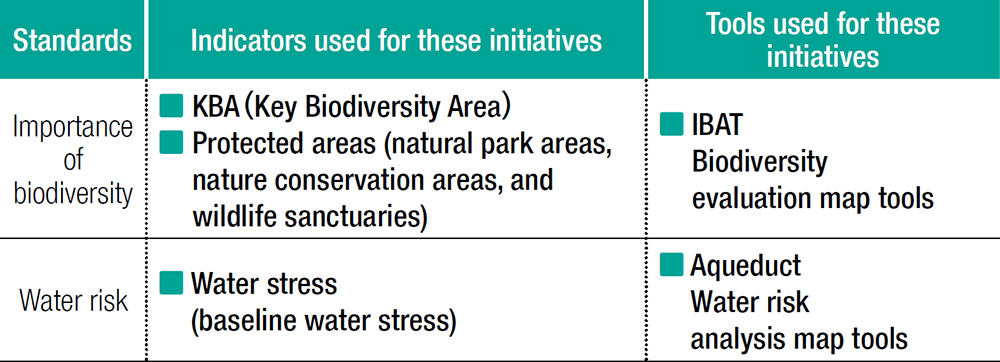
Diagnosis results
1) Biodiversity Conservation
In terms of communications equipment and data centers for which we conducted comprehensive research, we inquired with each municipality to try to determine whether there were any causes for concern regarding the effects of each facility on nearby ecosystems. As a result, we determined that there were no such causes for concern regarding the equipment we looked at, and the possible business risks are limited.
In terms of renewable energy (solar and wind power generation) equipment, we conducted an environmental impact assessment as stipulated by the Environmental Impact Assessment Act, etc., specifically investigating and assessing the impact on each ecosystem (flora and fauna).
The environmental impact assessment procedure involves a four-stage review based on the document on primary environmental impact consideration, scoping document, draft environmental impact statement, and environmental impact statement. The results are published on each company's website for a certain period in accordance with the law.
We also researched, predicted, and assessed the possibility of birds of prey colliding with wind power generation facilities. In the case of facilities for which such risks have been identified, we obtain the guidance and advice of specialists as we conduct long-term observation and implement development and maintenance management that consider the ecology of local birds, mammals, etc.
Focused Regional Evaluation (Communications Buildings, Data Centers)
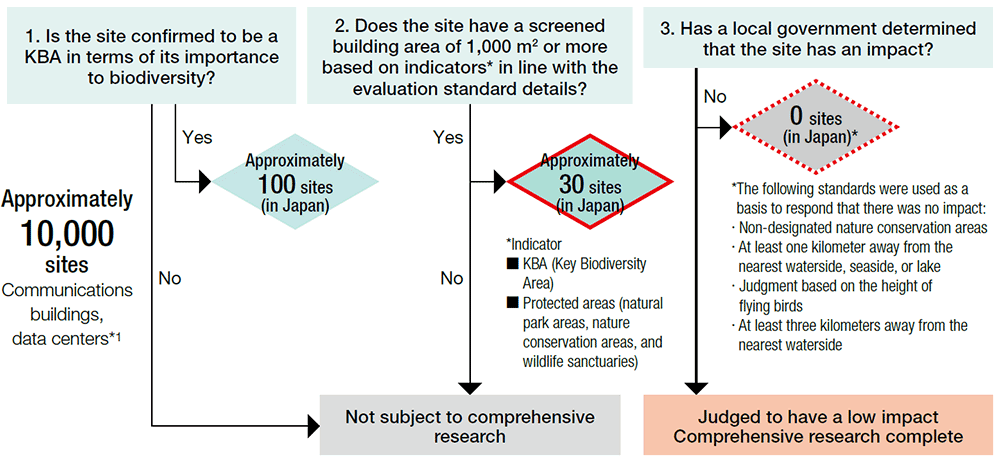
Environmental Impact Assessment Targeting Ecosystems Related to Renewable Energy Equipment
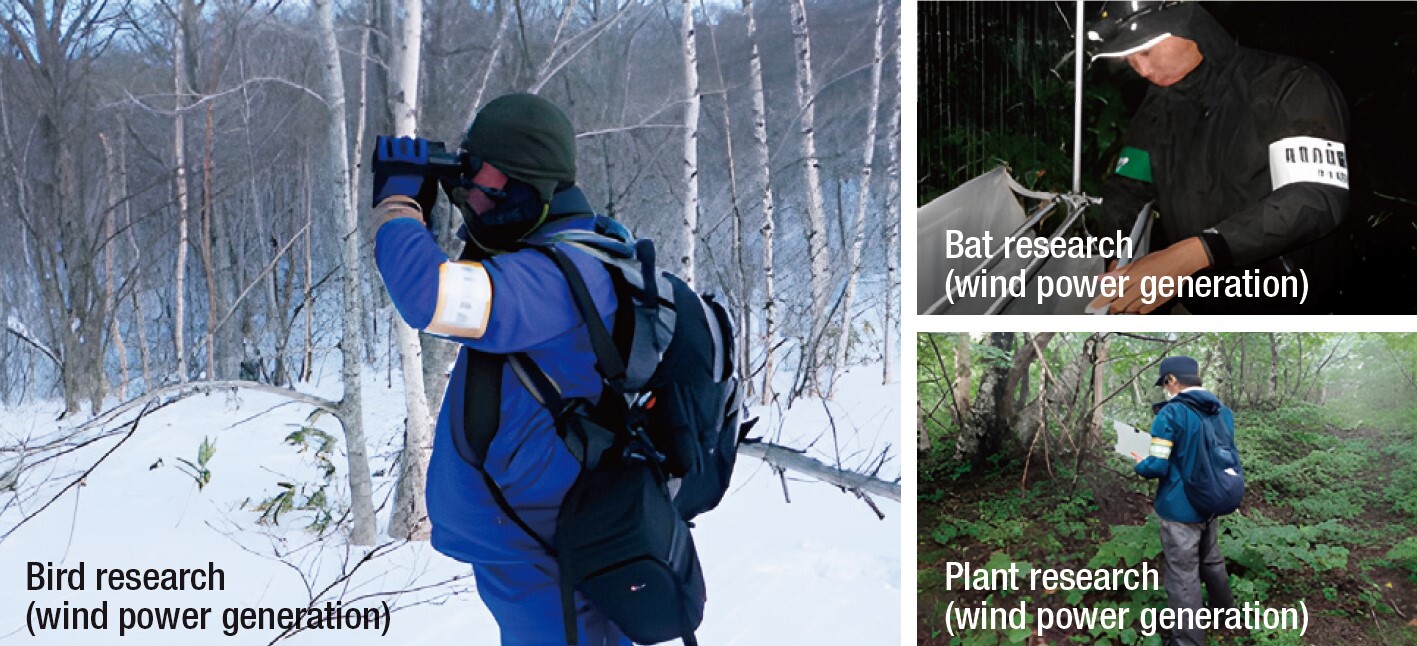
2) Water Utilization
As a result of our analysis, we learned that one of our sites in Southeast Asia is located in a region that has an extremely high level of water stress.
However, upon confirming the details of this particular data center, we learned that the local water supplier uses reverse osmosis membrane technology as well as treated recycled water and is therefore extremely careful regarding the utilization of water resources in the region.
According to our assessment, business continuity has also been assured even in the event of a drought, and there are only limited cases where a drought could affect operations.
*We assessed biodiversity risks at base stations separately using IBAT (Important Bird and Biodiversity Area Tool), and finding that approximately 3.3% of the base stations (steel towers) set up in Japan were located in important biodiversity areas, identified them as hot spots.
Contributing to Biodiversity Preservation and Transitioning to a Circular Economy
The NTT Group believes the increasing focus on biodiversity and a recycling-oriented society opens up new business opportunities. We will continue to contribute to the achievement of a sustainable society through our business activities. We will continue to verify and disclose risks and opportunities related to biodiversity and resource circulation for the NTT Group.
Forest Conservation
By actively promoting technological innovation aimed at conserving forests, we increase carbon dioxide absorption, conserve and protect ecosystems and water resources, and contribute to the achievement of a sustainable society.
For example, we have conducted an operational field demonstration of a self-driving underbrush clearing machine (called "the demonstration" below) developed to reduce the cost of clearing away underbrush through forestry labor-saving and automation.
During the demonstration, we used the above machine to clear away underbrush at an actual forestry site, thereby verifying the machine's operational performance.
The machine was operated by setting a self-driving route and using a tablet with a special application for remotely monitoring the vehicle installed on it.
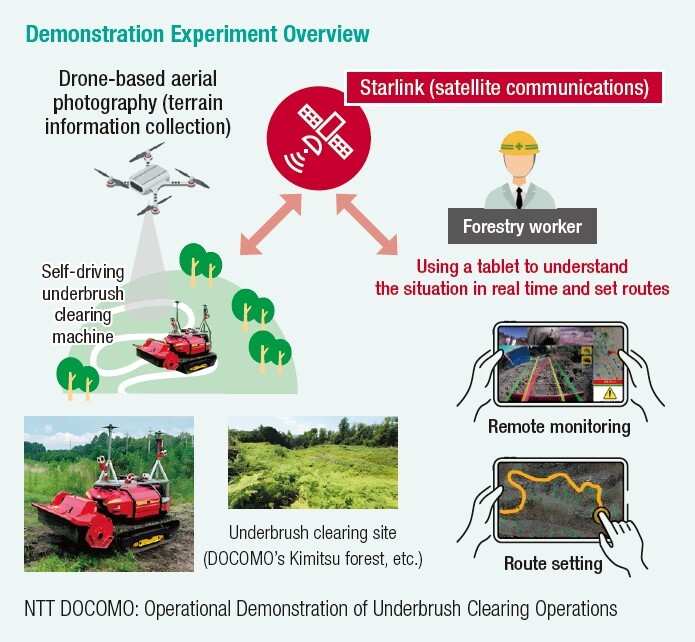
Appropriate Management of Water Resources
In Belgium, the NTT Group is aiming to optimize the use of water resources by installing sensors on home water meters to detect where problems occur. In addition, we have incorporated a predictive maintenance system that identifi es which pipelines are likely to require replacement or repairs. Water-tower and home water consumption can be analyzed via our network, and the collected data can then be used as a basis for utilizing AI to predict how much water is likely to be consumed in the next few days.
This makes it possible to draw only the necessary amount of water, which enables groundwater conservation.
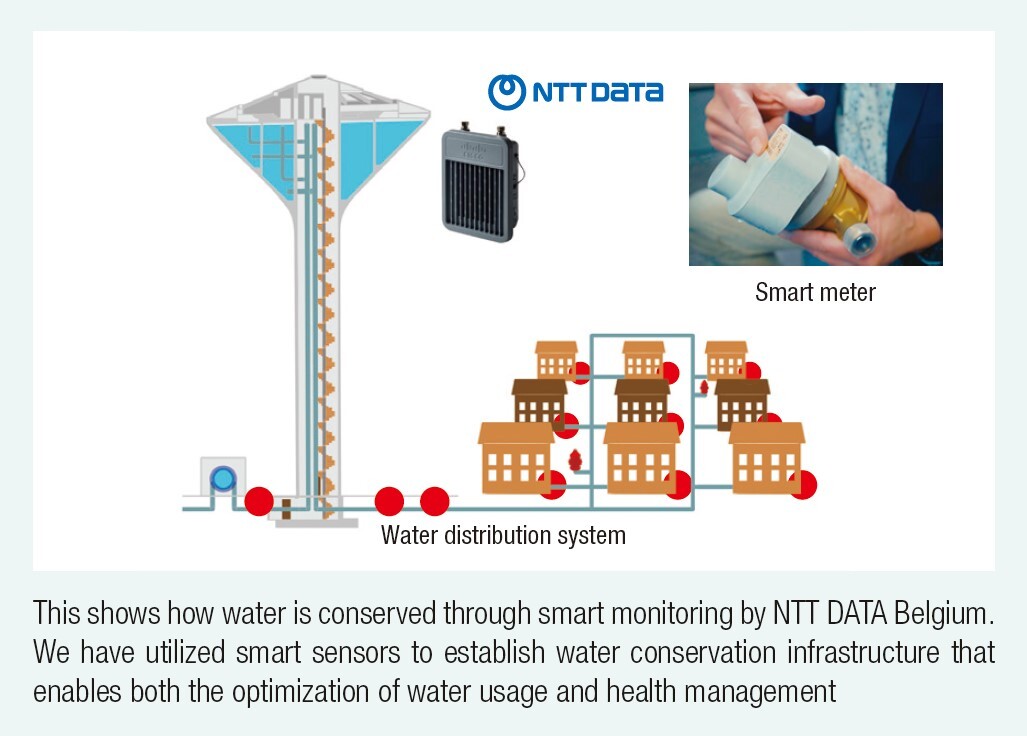
Promotion of Resource Recycling
We have established a battery traceability platform that enables the aggregation of supply-chain carbon footprint information (called "CFP information" below) and the visualization of recycling and reuse, and, in May 2024, we started providing services that enable companies to aggregate and share CFP information when manufacturing batteries.
Going forward, we will establish interoperability with our overseas databases, pursue global operations, and promote the handling of a circular economy for rare minerals.
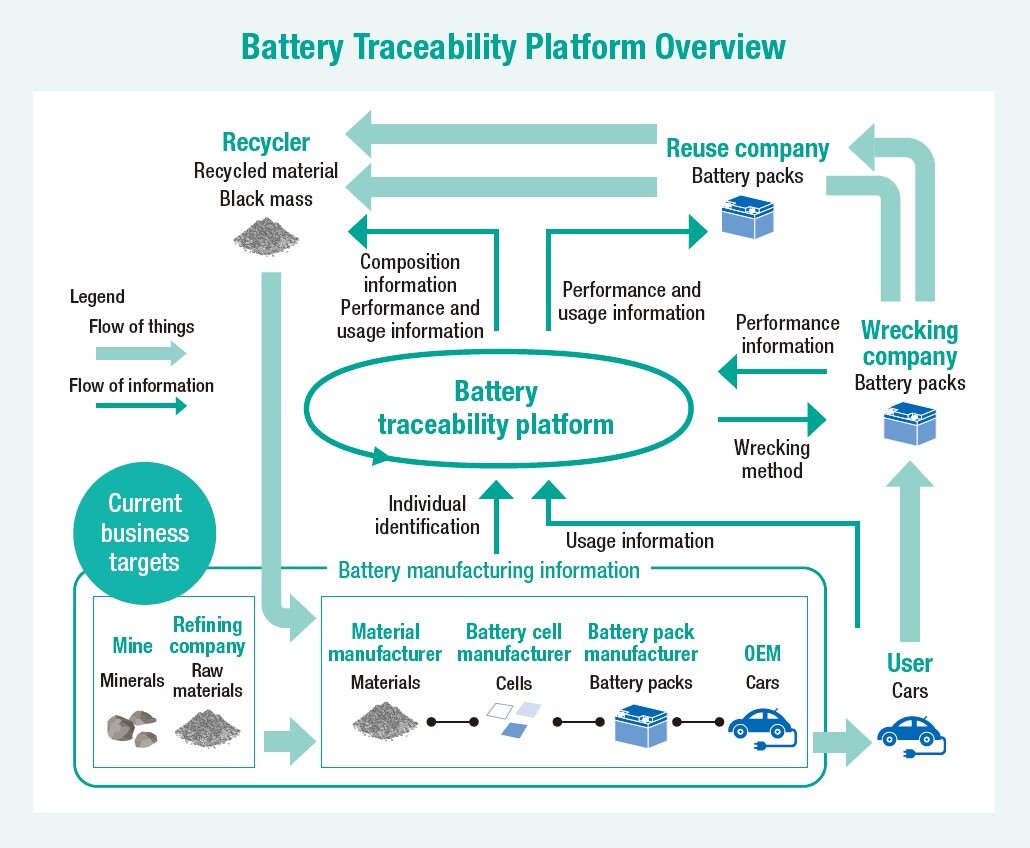
Raw materials procurement
Overview of nature-related risks at the mining stage of metal raw materials
For the mining stage of metal raw materials, we focused on copper, iron, aluminum, and rare metals as four major types of metals, and conducted an assessment of the primary mines in the major producing countries with large exports to Japan in terms of biodiversity and water risk. As a result of this assessment, we found that biodiversity risk is high at a very large number of mines, and water risk is also high in about half of the mines, which could have significant impacts on nature.
In order to promote efforts in the supply chain for the realization of a sustainable society, the NTT Group requests that suppliers comply with the NTT Group Supply Chain Sustainability Promotion Guidelines and NTT Group Green Procurement Standards, and conducts company and product evaluations as well as periodic surveys and studies of the status of environmental conservation efforts. Within these frameworks, we will strengthen our dialogue with suppliers regarding the conservation of nature and biodiversity, and discuss strengthening our efforts to conserve biodiversity and regional water resources in upstream processes, including the mining of metal resources.
Status of biodiversity risk and water risk associated with primary mining areas for metal resources
*You can scroll horizontally
| Metal type | Primary equipment used for | Ratio of locations in regions with high biodiversity risk | Ratio of locations in regions with high water stress |
|---|---|---|---|
| Copper | Power lines, Telecommunications equipment |
91.7% | 41.7% |
| Iron | Steel towers, antennas, building materials |
93.8% | 12.5% |
| Aluminum | Steel towers, antennas | 84.6% | 69.2% |
| Rare metals(tantalum) | Electronic parts | 85.7% | 57.1% |
| Total | 89.6% | 41.7% | |
Remarks
Biodiversity risk: Using the biodiversity risk assessment tool (IBAT), locations were judged as high risk if they were within 70 km of a KBA or conservation area.
Water risk: Using WRI Aqueduct 2019, production bases were judged as high risk if there was "High" or "Very High" Baseline Water Stress.
Also, ratios are based on the number of survey sites per metal type (major mines in primary producing countries) as the denominator. For rare metals, tantalum was selected in light of the availability of location data in primary statistics, keeping in mind the raw materials of electronic parts in the telecommunications business.
Regarding risks and opportunities for major sustainability-related items, matters are brought to the Sustainability Committee, then reported to the Board of Directors. Additionally, as part of the NTT Group's risk management process, the Business Risk Management Promotion Committee--headed by the senior executive vice president-- along with the Group Business Risk Management Promotion Committee are central to establishing and operating a PDCA cycle for risk management, with the aim of anticipating and preventing the occurrence of the potential risks close at hand and minimizing losses in the event that risks do materialize. The processes concerning the identification, evaluation, and management of sustainability-related risks are integrated into the NTT Group's overall risk management framework.
Indicators and Targets
This fiscal year, an overview of a business facilities screening is being published, while for risks, disclosures are being expanded by adding TCFD. Opportunities are being investigated by disclosing examples of solutions and more using ICT.
For indicators and targets that have not been disclosed, core metrics indicated in the TNFD Recommendations, European Sustainability Reporting Standards (ESRS), and more will be taken into consideration as future investigations are carried out.
Environment
NTT STORY
WEB media that thinks about the future with NTT










